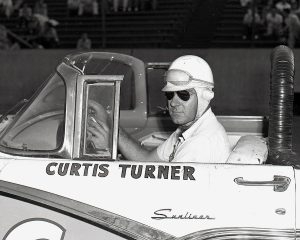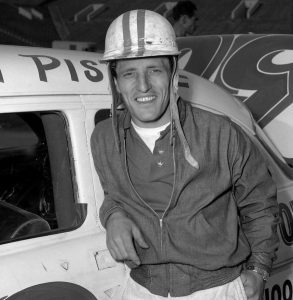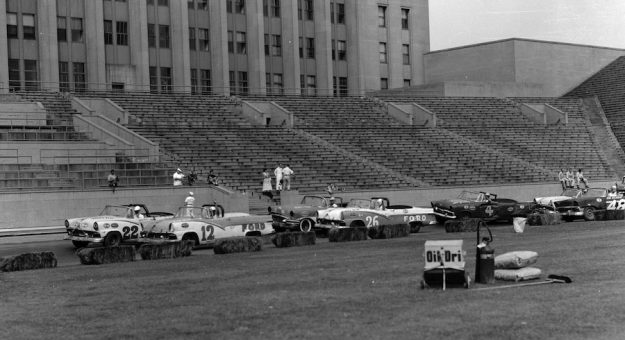With the NASCAR Chicago Street Race (July 1-2) approaching, let’s examine the history of NASCAR racing in and around America’s “Second City.”
The year was 1954 and the NASCAR Cup Series (known then as Grand National) was beginning its seventh season. Promoter Howard Tiedt and his associates booked a NASCAR date at Tiedt’s year-old Santa Fe Park Speedway near Willow Springs, Ill., for Saturday night, July 10. It marked the first visit by Bill France’s Florida-based organization to the Chicagoland area.
The Santa Fe event was the 24th race of 37 that were run in 1954 with a 100-mile/200-lap race planned for the half-mile dirt oval. A field of 23 started the main event with fast-qualifier and pole starter Buck Baker and his ’54 Oldsmobile shooting into the lead at the start.
Baker led the first 46 laps before Dick Rathmann took over the top spot. With a reported crowd of more than 6,000 fans on hand, Rathmann, who called Daytona Beach home at the time, drove his No. 3 Pure Oil-sponsored, 1954 Hudson to the checkered flag. Rathmann finished ahead of NASCAR regulars Herb Thomas (’54 Hudson), Hershel McGriff (’51 Oldsmobile), Baker (’54 Oldsmobile), Lee Petty (’54 Chrysler) and Jim Reed (’52 Hudson).

Racing out of Mundelein, Ill., Bill Moore, who had won a 200 lapper at Santa Fe the year before, turned in the best performance by a local driver, finishing 10th in a 1950 Plymouth.
Two years later, Soldier Field, along the Lake Michigan shore, was the site of three NASCAR-sanctioned events — a Cup Series contest and two NASCAR Convertible division races. Chicago Auto Racing, Inc. was the promotional group with W.H. “Bill” Schade as president and Edward Otto Sr., vice president. Anthony Granatelli was listed as chairman of the NASCAR Technical Committee.
With the Chicago skyline in the background, convertible racers came to town on Saturday night, June 30. Chicago native and local favorite Tom Pistone wheeled his 1956 Chevrolet “ragtop” to the victory in the 100-lap chase, beating NASCAR legend Curtis Turner. The track inside the mammoth stadium was described as half-mile paved oval.
A few weeks later on July 21, Edward Glenn “Fireball” Roberts topped the 200-lap Cup Series contest. Racing on a wet track caused by intermittent showers, Roberts drove his factory-backed 1956 Ford to the checkered flag. A crowd of 14,502 watched Roberts defeat Jim Paschal and Ralph Moody.
Billy Myers, in a ’56 Mercury, started on the pole of the 25-car field, which included Pistone and relative racing newcomer Fred Lorenzen, of Elmhurst, Ill.
The convertibles returned to Chicago on Sunday, Sept, 9, with Turner winning a 500-lap/250-mile contest on the Soldier Field oval. Turner, wheeling his DePaolo Engineering/Holman Moody ’56 Ford, defeated Joe Weatherly and Bob Welborn in front of 17,585 fans.

For the first portion of the 1956 season, Blue Island’s Raceway Park was run under NASCAR sanction. The track’s season-opening stock car program on April 1 was said to be the introduction of NASCAR-sanctioned sportsman stock car races to the Chicago area. Track management announced that the tight, quarter-mile paved oval would not be open when the NASCAR Grand National and convertible races were run at Soldier Field. But by midseason, Raceway Park and NASCAR had parted ways.
NASCAR returned to Chicago’s Soldier Field in 1957 with Glen Wood, of the famous Wood Brothers Racing team, winning a convertible division 100-lap contest. Wood and his ’56 Ford finished ahead of Possum Jones and Larry Frank on June 29, with 14,721 in attendance. It was the last time a major NASCAR division competed at a Chicago-area short track.
During the 1960 and ’61 seasons, O’Hare Stadium in Schiller Park, Ill., was a NASCAR-sanctioned track. The banked, quarter-mile paved oval hosted weekly short-track racing with the likes of Lorenzen, Gene Marmor, Bill Lutz, Roy Martinelli, Erik Johnson and Roy Czach in competition. Czach, who hailed from Chicago, was the NASCAR late model champion at O’Hare both years.
In 1984, Rockford Speedway, located 100 miles or so northwest of Chicago, became a Winston Racing Series track with the “Rockford Rules” late models and American Short Trackers under NASCAR sanction. The welcome letter in the 1984 souvenir program from track owners Hugh and Jody Deery mentioned, “You will notice some changes as soon as you catch your first glimpse of the speedway. The red, white and gold color scheme of the NASCAR Winston Racing Series will be prevalent throughout the physical facilities of the Rockford Speedway.”
Rockford Speedway is still part of the NASCAR Advance Auto Parts Weekly Series and will close its gates for the final time this season after 76 years of racing.
Santa Fe Speedway became part of the Winston Racing Series in 1987. Presenting stock car racing every Saturday and Sunday during the summer months, the highly popular clay track was be part of the NASCAR family until it closed after the 1995 season.
The short-lived Chicago Motor Speedway in Cicero, Ill., was the site of two NASCAR Craftsman Truck Series races. Joe Ruttman won in 2000 and Scott Riggs the following year. The paperclip-shaped, one-mile track ceased operations after 2002.
In 1999, plans for the new Chicagoland Speedway in Joliet, Ill., were announced. Seven-time Cup Series champion Dale Earnhardt, Dale Jarrett, NASCAR’s Bill France Jr. and other dignitaries attended the ceremonial groundbreaking for the speedway on Sept. 29, 1999.
Chicagoland Speedway, which boasted 75,000 seats, hosted NASCAR racing for the first time on July 15, 2001. Kevin Harvick wheeled a Richard Childress Racing Chevrolet to victory and Jimmie Johnson won the NASCAR Xfinity Series race the previous day.
From 2001 through 2019, the Cup Series raced at the 1.5-mile tri-oval located some 45 miles southwest of Chicago. Alex Bowman won the last Cup Series race there on June 30, 2019. Tony Stewart is the all-time Cup Series winner at the track with three victories.
Sitting idle since 2019, the fate of Chicagoland Speedway is yet to be determined.
Chicago and NASCAR are an interesting combination. Could the upcoming NASCAR Chicago Street Race be the beginning of a new chapter to the story?
This story appeared in the June 21, 2023 edition of the SPEED SPORT Insider.

